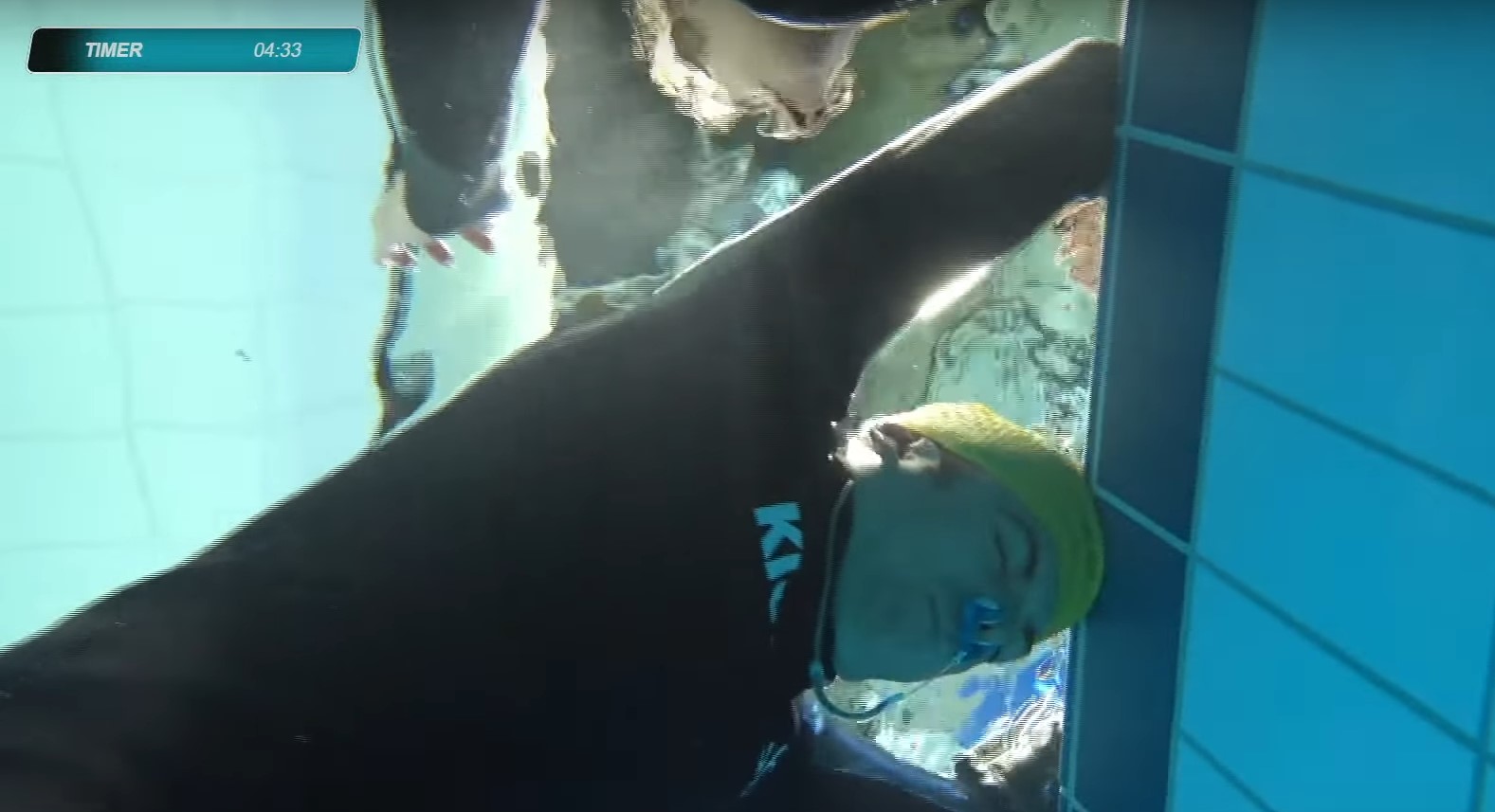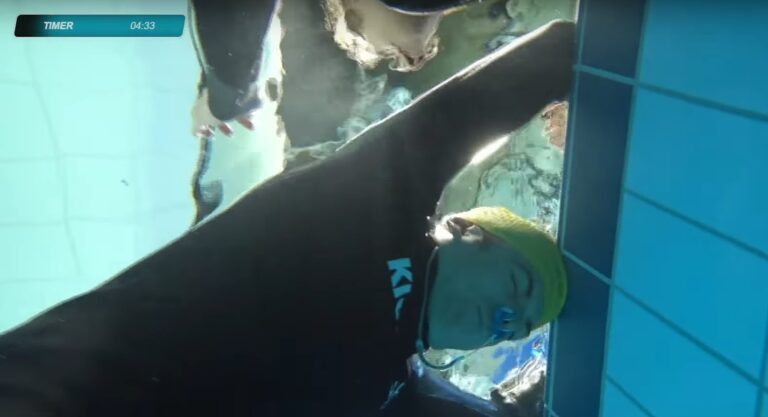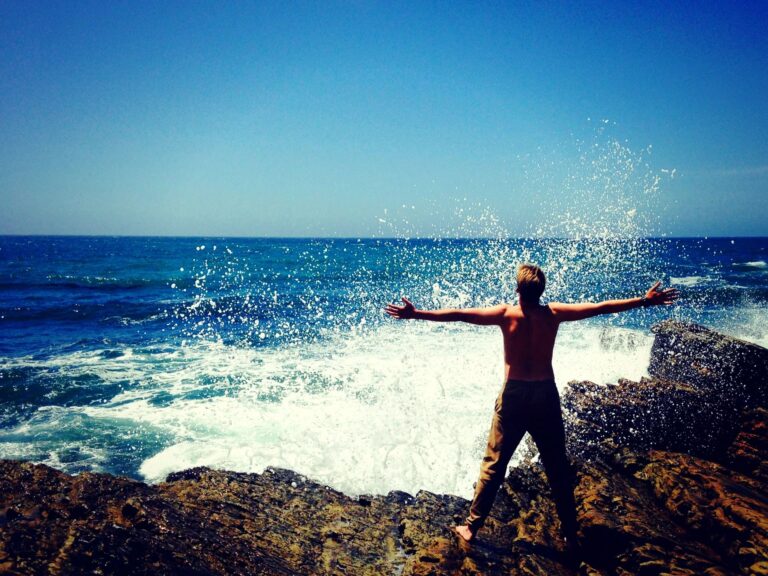Discipline description
Static apnea, defined as a discipline 1 of pool freediving, involves holding one’s breath for as long as possible with the airways (nose and mouth) immersed while floating on the water’s surface or standing on the bottom of a pool. The terms “static”, “STA” or “breath hold” are used interchangeably to refer to the same activity: how long one can hold their breath.
History
References to breath-holding activities can be found all around the world, from ancient to contemporary times: Ama divers in Japan, Korean haenyeo, the story of the Greek Sponge diver called Haggi Statti (Hazzi Stathi) who had recovered the anchor of the Santa Margarita, the Badjao (Bajau) tribe in the Philippines, pearl divers and many more stories can be found all over the internet. Though references to pure static apnea are hard to find, all the above-mentioned tribes or groups of people performe underwater breath-holding activities for a living. The skill of being able to hold their breath for extended periods of time was more of a secondary effect of their lifestyle.
Why does STA exist?
As you have read in previous articles published here, for almost every level of a course and regardless of the agency, there is a minimum static breath-hold requirement. The mind-body connection is exploited in freediving perhaps more than in any other activity. Most importantly, one must make the brain understand that there is no harm in not breathing for a while. Before getting into the infinite blue of the sea, you first must become comfortable holding your breath for a couple of minutes. This is because when out on the sea there will be other things to focus on. Knowing that you can hold your breath for way longer than the time it takes to dive down to 15 meters and back up (usually around 30-40 seconds) will give you the space to focus on everything else.
STA as a Distinct Discipline
Ever since freediving established itself as a sport, STA was one of the disciplines. Do not confuse it with Guinness World Record static apnea where the athlete breathes pure oxygen for a given time before the attempt.
Most of the time, including in the case of freediving course requirements, the maximum static breath holds are a result of adaptation to underwater activities and other training routines people do as preparation for courses, competitions, spearfishing, or even snorkelling vacations.
Should you decide to focus a little more on exclusively training STA for a while, this is what was available on the internet at the time of writing this article regarding the understanding of the topic.
Daring to try!
If you ask a random person, “How long you can hold your breath?” you will likely hear a guessed answer of 30-40 seconds. Surprisingly, this is true if you perform the hold right now. What is also surprising is that with a few minutes of slow breathing and relaxing while lying on the floor before a second attempt, you will see that you can easily double the first time. The only thing that changed was preparing your mind for it and putting your body in a relaxed state.
The Dive Response
When in contact with water or under stress related to water and breath-holding (pressure, temperature, increased levels of CO2, skin receptors that are triggered when in contact with water), something interesting happens to the body. The mammalian diving reflex, or according to more recent interpretations, “the dive response,” kicks into action and places the body into an energy-saving mode. The response appears to be a mix of several reflexes mentioned in this podcast episode 2 and generally triggers a few automatic reactions on the body:
- Bradycardia (your heart slows down)
- Peripheral vasoconstriction (decreased circulation in your extremities)
- Spleen contraction (the spleen is releasing the red blood cells it stores)
- Blood shift (primarily associated with depth )
NOTE: the dive response seems to be unique to everyone, and there have been cases where it does not behave as anticipated 3 (9).
NOTE: the good news is that the dive response together with adaptation to breath-holding can be trained 4 (8).
The 5 Phases of a STA Hold
First phase – It was already introduced as the preparation or relaxation phase. In a more common freediving language, it is called the “breathe-up” 5, which means everything you do and how you breathe in the 3-5 minutes leading up to a dive. By relaxing and moving as little as possible (simulating being asleep), the blood leaving your lungs towards your heart and further towards the rest of your body and muscles will be fully loaded on O2. Because you are relaxed and not moving, blood returning through your veins to the heart will also be rich in O2. This basically allows more O2 to be available in your body, already bonded to the red cells of your blood, before your start a dive.
Second phase – After submerging your face in water, the dive response kicks in. If you pay attention, most likely feel the temperature of the water on your face and you will be able to hear or feel your heart slowing down. Usually, people describe a feeling of calmness during this phase.
Third phase – At this point you may become a bit restless and get bored or start wondering what’s going on. It could be described as a feeling of raising tension. For those just starting their journey with STA this phase may be short and unnoticeable.
Fourth phase – During this phase your body starts noticing that the CO2 saturation threshold, currently understood as a limit, has been reached and pushes you to act towards exhaling the air contained in your lungs. In other words, your diaphragm and other breathing muscles will start contracting, giving you contractions. Moving muscles consume oxygen, so your body will start accelerating the consumption of the remaining oxygen reserves. Each of us react differently to this phase, and it is important to progress slowly and safely, ideally accompanied by someone more experienced, to understand your body and get used to the feelings and sensations that occur.
Fifth phase – After a breath-hold it is important to reoxygenate as quickly as possible. This is crucial for all your organs but primarily the brain, which keeps you conscious.
Low oxygen saturation, known in medical terms as hypoxia, can be tolerated by the brain depending on your level of training and experience. However, in extreme situations when the oxygen levels are very low (a.i. you are hypoxic) the brain will be forced to take actions to prolong your life. In this case, a new level of energy-saving mode is reached, known in the freediving world as “blackout”. During a course, training with a buddy, or in a competition, there are rehearsed and pre-established procedures for waking someone up from such a state.
NOTE: Hitting a CO2 threshold will trigger some discomfort and contractions, by this point the O2 saturation starts decreasing as well. There is no warning for hitting the O2 threshold and reaching it will result in blackout.
Remember that the power of the mind is greater than the power of the body. Always train with a buddy!
Menstrual Cycle Influence
There is not much scientific literature dedicated to studying max breath holds during different menstrual phases in trained freedivers. A study conducted on 12 non-freediving individuals in 2020 concluded that “The main finding of this study was that the maximal breath-hold time was greater during midluteal compared to early follicular phase of menstrual cycle.” 6 . Looking further into the topic, a personal experience of a trained freediver came up. She also conducted a questionnaire on other trained freedivers. The summarised feedback did not reach a definitive conclusion but leaned more towards how the effects of the menstrual cycle are linked to the individual 7. Read the entire article here.
Gear for STA (wet suit & face gear: mask, goggles & nose clip, nose clip, no face gear)
For training STA in the pool, the most important thing is to feel comfortable. If the water temperature is comfortable for you, there is no need to wear a wetsuit. However, most people prefer wearing one because heat loss in water is much more rapid than in the air. This means that you will start feeling cold much faster.
In addition to a wet suit, you will see that people use various combinations of one or more of the following items: neoprene hood, a swim cap, a diving mask, swimming goggles, a nose clip, or no face gear at all. Most of the time, it is a matter of what makes you comfortable.
For dry training, on a mat or on a couch, no gear or just a nose clip does the trick. Same as in the water, comfort is what drives the choice.
Continue reading part 2 of the article where are presented a few things people experimented with in order to increase the length of their breath holds (2 of 2) Breath hold, static apnea, STA“
Footnote resources:
- STA definition (11) https://www.aidainternational.org/competitive ↩︎
- Marcin Baranowski interview (9) Episode 90 – Physiology of Freediving ↩︎
- Marcin Baranowski interview (9) Episode 90 – Physiology of Freediving ↩︎
- Erika Schagatay interview (8) Episode 42 – Science of Freediving ↩︎
- William Trubridge – the breatheup (16) Blogpost the breatheup ↩︎
- The effect of menstrual cycle on maximal breath-hold time (18) article link ↩︎
- Paula Johnsson article (19) Freediving on your period ↩︎


